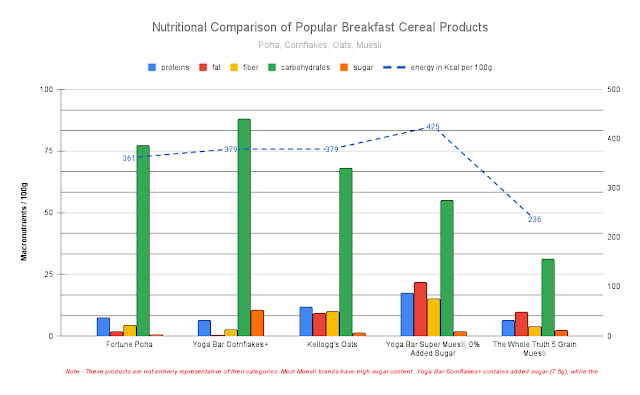Refining the Truth: A Nutritional Breakdown of Oils 📊
I analyzed 99 Ghee & Oil products (with known nutrition facts as of September 26, 2024) from the India database on Open Food Facts—the "Wikipedia of food."
The data, sourced from Open Food Facts and subsequently cleaned, is available on GitHub in CSV format. You can explore the curated datasets for Ghee & Oils conveniently using the online Flat Viewer tool or through Excel or any other spreadsheet software after downloading it.
The following chart can help you compare different types of cooking oils and make informed choices based on your individual needs and preferences. It shows the amounts of saturated fat, monounsaturated fat (MUFA), and polyunsaturated fat (PUFA) for each product. All these types of fats offer approximately 900 kcal of energy, with 0g protein, 0g carbs, and roughly 100g fat per 100g serving.
The chart has been created using data from Open Food Facts and validated with nutrition labels on Amazon for these branded food products:
- Coco Soul Coconut Oil
- SriSri Tattva Cow Ghee
- Ruchi Gold Palmolein Oil
- Freedom Groundnut Oil
- Healthy Heart Rice Bran Oil
- Saffola Gold Blend of Rice Bran Oil & Sunflower Oil
- Fortune Soyabean Oil
- Jivo Extra Light Olive Oil
- 24 Mantra Organic Mustard Oil
- KLF Tilnad Gingelly Oil
Unraveling Nutrition-Related Keywords
* Fatty Acids: These are the building blocks of fats and oils.
* Types of Fatty Acids:
- SFA (Saturated Fatty Acids): Consuming too much saturated fat can raise LDL (bad) cholesterol levels, increasing the risk of heart disease. Moderation is key.
- MUFA (Monounsaturated Fatty Acids): Considered "good" fats, MUFAs can help lower your risk of heart disease, stroke, and other chronic diseases.
- PUFA (Polyunsaturated Fatty Acids): Also considered "good" fats, PUFAs offer similar health benefits to MUFAs.
Types of Vegetable Oils
* Crude Vegetable Oils:
- Extracted from seeds (sunflower, soybean, mustard, etc.) or fruits like palm and olive via mechanical extraction.
- Often contain harmful residues, such as pesticides and allergens.
* Refined Vegetable Oils:
- Refining removes odors and extends shelf life but also eliminates beneficial components like antioxidants and phytosterols without altering the fatty acid profile.
- While refining removes undesirable compounds, it can introduce additives such as preservatives, necessitating moderate consumption. Tert-butylhydroquinone (TBHQ, E319) is one such additive that is commonly used.
* Virgin Oils:
- Produced by mechanical procedures (expeller pressing) and heat application.
- Generally considered healthier than refined oils due to their minimal processing.
* Cold-Pressed Oils (Kachi Ghani):
- Extracted from seeds or nuts without using heat or chemicals.
- Retain nutrients like antioxidants.
Additional Considerations
* Cholesterol: Plant-based foods and oils do not contain cholesterol, but ghee and butter do.
* Fortification: The Food Safety and Standards Authority of India (FSSAI) is considering making fortification of edible oil with vitamins A and D mandatory. Many cooking oil brands already sell fortified oil, which can be identified by the FSSAI's fortification logo—F+.
* Agmark: A government-approved certification mark in India that guarantees the quality and purity of agricultural products, including oils. Look out for the Agmark along with the fortification logo.
Dietary Recommendations
* Reduce the use of high saturated-fat containing oils/fats such as ghee and butter.
* Minimize consumption of ready-to-eat fast foods, bakery foods, and processed foods that may contain trans fats and saturated fats.
* Avoid partially hydrogenated fats (vanaspati) as the cooking medium due to their trans-fat and saturated fat content.
* Repeated heating of cooking oils generates harmful oxidative (polar) compounds and should be avoided. If you must, filter used oil for curry preparation but avoid reusing for frying. Consume used oils within a day or two to minimize deterioration.
The best type of oil for you may depend on your individual health needs and dietary goals. It's always a good idea to consult with a healthcare professional or registered dietitian for personalized advice.
Fun Fa(c)ts
- Rice bran oil is one of the richest natural sources of oryzanol, making it a popular choice for health-conscious consumers.
- Oryzanol is a powerful antioxidant that has been shown to have anti-inflammatory, anti-cancer, and anti-aging properties.
- Ghee, or clarified butter, is virtually lactose-free. It is made by simmering butter and skimming off the milk solids, leaving behind pure butterfat.
- In Ayurveda, the oldest of the world's holistic healing systems, ghee is considered a superfood and is used in various remedies and treatments for its nourishing and healing properties.
- Ghee is mentioned in the ancient Ayurvedic text, Charaka Samhita (400 CE).
- Coconut oil has a long shelf life and is resistant to rancidity, making it a practical choice for long-term storage. It can last up to two years if stored properly.
- 57% of India's edible oil demand is met through imports.
- Palm oil is the single largest consumed oil (38%), closely followed by soybean oil (22%) Tata Trusts.
- India has over 15,000 oil mills and more than 250 vanaspati manufacturing units.
Also see -



Comments
Post a Comment